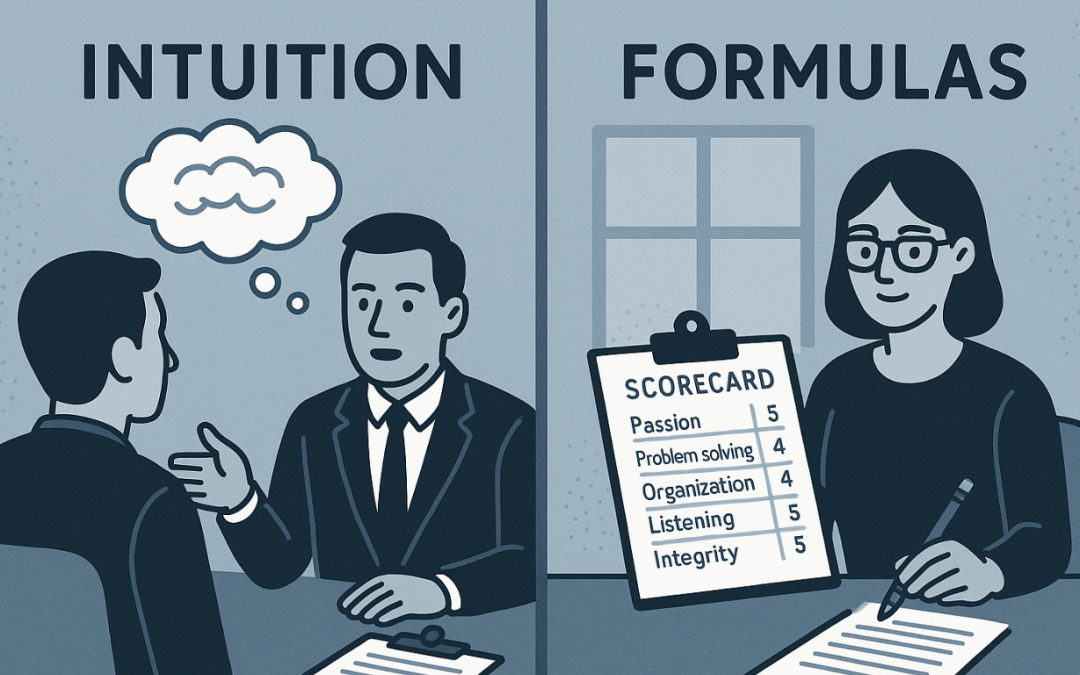
by Art Waskey | Aug 21, 2025 | Art of Sales Weekly, Featured
Early in my career, I worked for an international distribution company with a steep corporate ladder to climb. As a sales manager, I oversaw a quarter of the country — from Colorado to Florida. This required a lot of travel. I met weekly with 8 different reps at various airports. When the corporation reorganized, I was offered a Vice President’s position. I aspired to eventually run a major enterprise. Would accepting the VP position help me meet that goal? Would that be a good decision for a balanced life?
First things first
The VP offer represented a big step up the corporate ladder. I was 35 and happily married with three young children. This was a big life decision. As suggested by Steven Covey in his book The Seven Habits of Highly Successful People, I looked at my “first things first” priority list — God, family, and then career. I worried that this new position would take me even farther away from family life.
Finding a balance
An independent distributor heard of my concerns. He was in the process of taking over the family business from his father. He saw me as a good candidate to help him grow that business. This meant I would be home more often, which represented a good life balance for me. I accepted.
Three guiding principles
Life-changing career decisions are challenging. Here are some guiding principles to consider when you find yourself at a crossroads.
- Personal Integrity – Does this position align with my understanding of personal integrity? People rise and fall based on this important quality. The best way to assess your integrity is to ask yourself: Who am I when no one is watching? Strive to be beyond reproach, temperate (sober-minded and clear-headed), and self-controlled.
- Family Life – The foundation of family is honoring and supporting your spouse’s priorities. Will this new position allow me to build on that foundation? In our 53 years of marriage, a road of compromises has assured a straight pathway for our family and a clear direction for our children.
- Relational Health — Will this new position enable me to treat others the way I would like to be treated? As the late Zig Ziglar reminded us, “People don’t care how much you know until they know how much you care.” Show others hospitality, keep your ego in check, and demonstrate humility.
A work in progress
I have used these guiding principles during my 50-year-plus career. These principles are never fully achieved. To own them requires developing habits around them. Lastly, balancing life decisions should always be considered a work in progress.
Get tips and tricks like the above in The Art of Sales books. Or subscribe to the FREE monthly articles here.

by Art Waskey | Aug 6, 2025 | Art of Sales Weekly, Featured
Like so many areas of business, the art of strategic planning has been greatly altered by the introduction of new technology. Software applications and Artificial Intelligence (AI) have greatly improved our ability to project and make a strategic plan.
Three questions
I suggest you ask these three questions when making your strategic plan.
- How are changes in technology affecting your operations? When developing a strategic plan, be sure to consider how the use of artificial intelligence (AI) is impacting your operations. A recent report from the Harvard Department of Education looked at the use of artificial intelligence (AI) by generations. The report highlights that younger employees are using AI generative agents at work, with 65% of users being Millennials or Generation Z. In contrast, 68% of non-users are from Generation X or the Baby Boomer generation. Half of the surveyed teens also reported using generative AI.
- What differentiates your company? Personalization is your greatest asset. Make this a critical part of your strategic plan. Focus on your company’s unique expertise and skills. These allow you to offer value-added services and local visibility. Look at ways to improve bundling, assembling, repairing, and customer training. Utilize advanced technologies to enhance your personalized differentiators. Regulatory pressures and cost challenges will continue to slow the pace of competing online e-commerce verticals, as well as other evolving companies and AI-native startups. Leverage personalization to increase your market share.
- What matters most to your customers? What continues to set the distributor apart from Amazon, Granger, Home Depot, and other evolving companies? It is clear that customers still value trust, adaptability, and strong local relationships. In your planning, consider how you can focus on person-to-person availability in new ways that will generate greater profits for both parties. This includes using AI technology. AI can lower costs in areas like order automation, product information enhancement, marketing, and returns processing. It also improves customer personalization by providing timely insights into customer behavior changes. Be sure to make targeted investments in digital technology, particularly AI applications.
Make a plan
In conclusion, consider developing a plan that takes into account how technology, such as AI, is affecting your business while also prioritizing the needs of your customers.Success will follow!
Get tips and tricks like the above in The Art of Sales books. Or subscribe to the FREE monthly articles here.

by Art Waskey | Jul 30, 2025 | Art of Sales Weekly, Featured
Traditional forecasting
When I retired from a very successful distribution company in 2018, we were creating our strategic plan using the most current and sophisticated methods available. Sales forecasting is achieved by analyzing previous sales cycles and following leading economic indicators.We also reviewed other companies’ and suppliers’ forecasts in our distribution vertical. Using that information, we projected our top customer sales.
We created our five-year strategic plan using a combination of SWOT analysis, future asset development, and market share projections. We also evaluated the potential impact of adding new locations and products. Given the tools available at that time, these methods yielded the best planning results. Today, new technologies enable us to sharpen that forecast.
Unforeseen events
The above type of strategic planning could not foresee the effects of a global pandemic, 2023’s inflation, supply chain immobilization, generative AI, international wars, and tariff corrections. Also, each of those forces impacted how distributors operate, compete, and, most importantly, plan for the future. Moreover, to effectively compete in today’s technologically fueled market, new methods need to be added to traditional strategic forecasting techniques.
Keeping up
To continue to build resiliency in your strategic planning, keep up on new methods through sources like Distribution Strategy Group, National Association of Wholesaler-Distributors, and their affiliate, Modern Distribution Management.
It is especially important to keep an eye on Artificial Intelligence (AI) applications. AI technology both reduces the cost of doing business and improves customer personalization. Lastly, these initiatives are critical to a good strategic plan.
Exciting times
We live in an exciting time for distribution. How do you plan for the future? You sharpen your forecasting skills by including the use of new technology and improving customer personalization in your strategic planning.
Get tips and tricks like the above in The Art of Sales books. Or subscribe to the FREE monthly articles here.

by Art Waskey | Jul 23, 2025 | Art of Sales Weekly, Featured
Using intuition
As a consultant, I am often asked to interview potential new executive employees for my clients. In my sales management career, I hired many outside sales representatives. When interviewing, I relied heavily on intuition and my success rate was above average — in the 70% range. However, I recently read Thinking, Fast and Slow by Daniel Kahneman, which challenged me to rethink the evaluation process. In a chapter, “Intuitions versus Formulas,” one of Kahneman’s key axioms is, “Whenever we can replace human judgment by a formula, we should at least consider it.” While intuition served me well in interviewing, I see now that scoring behavioral characteristics can yield a more accurate assessment.
The formula
When developing a formula for your hiring process, consider these steps:
- Select traits – Create a way to measure up to six specific traits, such as passion, problem solving, organizational skills, work ethic, listening skills, and integrity.
- Make a list of questions for each trait.
- What are you passionate about? The candidate needs to be able to provide an example.
- What was your toughest career problem? The candidate should be able to provide an example and a solution.
- How do you prepare for a week’s work? The candidate should be able to demonstrate organizational skills.
- How many hours do you work per week? The candidate needs to tell you that he is willing to work more than 40 hours per week and that he will work however long it takes to finish a project, solve a problem, etc.
- If someone comes to you with a personal issue, what do you do? The candidate should respond, “Listen” and “Give them help or refer them to someone who can.”
- What do you value in a company’s culture? The candidate needs to include integrity, truth, etc.
- Score each trait – Rate the traits on a 1-5 scale, from “very weak” to “very strong.” Think through each question and what significant qualities would make a difference on your scoring. Avoid the “halo effect” — the tendency for an impression created from the answer of one trait to influence your opinion in another area. Score the answer given for each trait before moving to the next.
- Total final scores – Firmly resolve that you will hire the candidate whose final score is the highest, even if there is a candidate whom you like better. You are much more likely to find the best candidate using this process than only trusting your intuitive judgment.
Raise your hiring success rate
Kahneman suggests, “Let’s decide in advance to give credence to the scores on the data from the candidate’s past performance. Otherwise, we will give too much weight to our impression from the interview.” To raise your hiring success rate, use a formula. Choose the candidate whose final score is the highest and let intuitions take a back seat.
Get tips and tricks like the above in The Art of Sales books. Or subscribe to the FREE monthly articles here.

by Art Waskey | Jul 16, 2025 | Art of Sales Weekly, Featured
AI continues to be in the news and increasingly in your life. If it’s not part of your business plan, be sure to include it now. For example, here are a few things I recently read that speak to the importance of adopting and introducing AI tools to your workforce.
Prioritize your workforce
According to PR Newswire, a report by Kyndryl, an AI enterprise technology services firm, sounds the alarm on the necessity to adopt AI. Michael Bradshaw, global practice leader for applications, data, and AI at Kyndryl, stated: “Only a small group of businesses have been able to harness AI successfully for business growth. This report shows that while data architecture and technology infrastructure are key pieces of the puzzle, organizations that do not prioritize their workforces will miss out.”
Kyndryl reported on HRDive, explaining, “Few companies have aligned their workforce strategies with their artificial intelligence investments, leaving a major gap in preparedness and talent needs…AI adoption faces three barriers: organizational change management, a lack of employee trust, and workforce skills gaps.”
Digital enterprise education
Although it is clear that the digitalization of our society through social media, education, and personal purchasing has significantly impacted our employees. The larger issue is that most distributors are lagging in digital enterprise education. Moreover, businesses need to teach employees how to use digital technologies to drive business performance and competitiveness. Also, if you want your employees on board, it is your responsibility to keep them technologically competent!
Follow the leader?
I recently read in The Guardian that Amazon is testing humanoids for “warehouse to front door” delivery. “The indoor obstacle course being used for the tests at an Amazon office in San Francisco is about the size of a coffee shop,” the report said, “with the company hoping the robots will be able to travel in Amazon’s Rivian vans and make deliveries from them.”
Use AI tools
“Nearly 7 in 10 companies now use AI tools for work,” according to an OwlLabs survey of knowledge workers. Are your employees experiencing rapid advancements in digital technology every day? If that’s the case, why don’t we challenge them to do the same at work? When your Gen Y, Z, and Alpha team members don’t see opportunities to grow their skills, they won’t stick around. So if you don’t address this gap, your organization will fall behind the competition.
Workforce priority
Despite today’s digitally driven market, having the right data architecture and technology infrastructure is essential. Additionally, to ensure the successful use of digital tools, organizations must prioritize training their workforce on the applications of AI.
Get tips and tricks like the above in The Art of Sales books. Or subscribe to the FREE monthly articles here.





